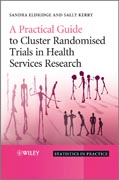
A practical guide to cluster randomised trials inhealth services research
Eldridge, Sandra
Ukoumunne, Obioha
There is relatively little literature on cluster randomized trials, with onlytwo previous books on the subject, both now quite old, and neither were focused on the practical aspects of the trials. This book provides that much neededpractical guide to the design, execution and analysis of cluster randomized trials in health services research. It also provides an overview of the topic'snumerous recent developments since the 2000 publication of the last book in this area. The opening chapter defines and introduces cluster randomized trials, before going on to present an overview of the subject's history and recent developments. The following chapters focus on all the major issues presented inthe order in which investigators think about issues when they are designing atrial. The chapters focus on: trial quality, reporting, how to design an intervention, how to ensure the validity of results, how to choose both the designand the analysis of the trial, sample size calculations, choosing an intra-cluster correlation coefficient, the uses of piloting, how to conduct a cost-effectiveness analysis, and how these trials should be synthesized. The book alsocontains numerous tables, graphs and diagrams and a substantial number of recent trials. INDICE: Foreword Preface Nomenclature/Notation Table of Cases Chapter 1 Introduction 1.1 Introduction to randomised trials 1.2 Explanatory or pragmatic trials 1.3 How does a cluster randomised trial differ from other trials? 1.3.1Recruitment, randomisation and consent 1.3.2 Definition of cluster size 1.3.3Analysis and sample size 1.3.4 Interventions used in cluster randomised trials 1.4 Between cluster variability 1.4.1 Factors that contribute to between cluster variability 1.4.2 Measuring between cluster variability 1.5 Why carry outcluster randomised trials? 1.5.1 The intervention necessarily acts at the cluster level 1.5.2 Practical and/or ethical difficulties in randomising at cluster level 1.5.3 Contamination at health professional level 1.5.4 Contamination between members of a cluster 1.5.5 Cost or administrative convenience 1.5.6 Ensuring intervention is fully implemented 1.5.7 Access to routine data 1.6 Quality of evidence from cluster randomised trials 1.6.1 External validity 1.6.2 Internal validity 1.6.3 Balancing internal validity, external validity and ethical issues 1.7 Historical perspectives 1.7.1 Early cluster randomised trials 1.7.2 Early cluster randomised trials in health up to 2000 1.7.3 Recent methodological developments 1.8 Summary Chapter 2 Recruitment and ethics 2.1 Selecting clusters and participants to enhance external validity 2.1.1 Clusters 2.1.2 Participants 2.2 Ethics of cluster randomised trials 2.2.1 Components of consent 2.2.2 Classification of interventions and implications for individual participant consent 2.2.3 Cluster guardians 2.2.4 Timing of cluster consent 2.2.5 Fully informed consent for educational and awareness campaigns 2.2.6 Protectingthe privacy of individuals 2.2.7 Duty of care to control participants 2.2.8 Summary of ethical consent issues 2.3 Selection and recruitment of participantsto enhance internal validity 2.3.1 Trials which identify and recruit individual participants before randomisation 2.3.2 Trials where individual participants are not recruited 2.3.3 Trials where patients are recruited after randomisation but blind to allocation status 2.3.4 Trials where recruitment is carried out after randomisation and where the recruiter knows the allocation 2.3.5 Selection bias; summary 2.4 Retention of participants in the trial 2.5 Summary Chapter 3 Designing interventions 3.1 Lack of effectiveness of interventions evaluated in cluster randomised trials 3.2 What is a complex intervention? 3.3 Phases in the development of a complex intervention 3.4 Identifying evidence for potential intervention effect (pre-clinical phase) 3.5 Understanding more about intervention components (modelling phase) 3.6 Developing the optimum intervention and study design (exploratory trial phase) 3.7 What is the intervention?3.8 Summary Chapter 4 Pilot and feasibility studies 4.1 What is a pilot
- ISBN: 978-0-470-51047-6
- Editorial: John Wiley & Sons
- Encuadernacion: Cartoné
- Páginas: 304
- Fecha Publicación: 06/01/2012
- Nº Volúmenes: 1
- Idioma: Inglés
